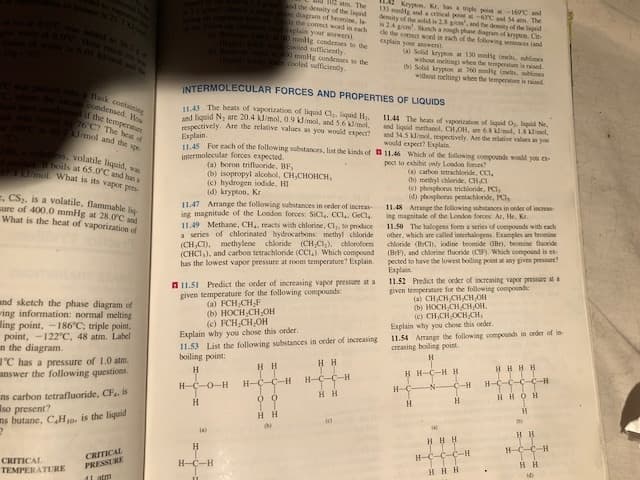1.4 The heats of vaporization of liquid Cl, liquid H d liguid N are 20.4 kJ/mol, 0.9 klimol, and 56 l. spectively. Are the relative values as you would expect Explain
1.4 The heats of vaporization of liquid Cl, liquid H d liguid N are 20.4 kJ/mol, 0.9 klimol, and 56 l. spectively. Are the relative values as you would expect Explain
Chemistry: Principles and Reactions
8th Edition
ISBN:9781305079373
Author:William L. Masterton, Cecile N. Hurley
Publisher:William L. Masterton, Cecile N. Hurley
Chapter9: Liquids And Solids
Section: Chapter Questions
Problem 20QAP
Related questions
Question
Number 43 please

Transcribed Image Text:Krypton. Kr. has a igle p M
13mtg and a critical poit-C and 54 The
density of the solid in 28 giom,nd the desity of the liquid
stm. The
he denity of the liquid
agram of beomine, la
Seecorect word in each
plain your anwers).
mlg condenses to the
16C and
is 24 picm. Sketch a ough phane đagram of krypton. Cit-
ded
dde the comect woed in each of the folowing seces (and
esplain your answen)
G Solid krygton at 130 meig (me, hlimes
without melting) when the temperatam is raised
(h) Solid krypton at 760 mmig ets, blimes
without melting) when the temperat is ised
so ooled sufficiently
wwwch o w
Ot klind snd
R0mig condenses to the
wldy e coeled sufficiently.
INTERMOLECULAR FORCES AND PROPERTIES OF LIQUIDS
lak containing
condensed. He
1143 The heats of vaporization of liquid Cl, liquid H,
nd liquid N. are 20.4 kJ/mol, 0.9 kl/mol, and 56 imel,
Espectively. Are the relative values as you would expect?
Explain.
1.45 For each of the following substances, list the kinds of 11.46 Which of the following componds woul you es-
intermolecular forces expected.
(a) boron trifluoride, BF,
(b) isopropyl alcohol, CH,CHOHCH,
(c) hydrogen iodide, HI
(d) krypton, Kr
et the temperature
76 C The hear d
CR07mol and the
11.44 The heats of vaporization of liquid O liguid Ne.
and liquid methanel, CH.OH, are 68mol, Limel,
and 34.5 kl/mol, respectively. Are the relative values a you
would expect? Explain
oledes, volatile liquid,
boils at 65.0°C and hasa
44mol. What is its vapor pres-
pect to exhibit only London forces?
(a) carbon tetrachloride, CCI,
(b) methyl chloride, CH,CI
(e) phosphorus trichloride, PCI,
(d) phosphorus pentachkoride, PCl,
11.48 Amange the folowing ubstances in order of increas
ing magnitude of the London forces: Ar, He. Kr.
E. CS., is a volatile, flammable lie
ure of 400.0 mmHg at 28.0C and
What is the hcat of vaporization of
11.47 Arrange the following substances in oceder of increas
ing magnitude of the London forces: SiCl. CCI,, GeCl
11.49 Methane, CH.. reacts with chlorine, Cl, to produce
a series of chlorinated hydrocarbons: methyl chloride
(CH,CI). methylene chloride (CH,C1,). chloroform
(CHCI,), and carbon tetrachloride (CCL). Which compound
has the lowest vapor pressure at room temperature? Explain.
11.50 The halogens form a series of compounds with cach
other, which are called interhalogens. Examples are bromine
chloride (BrCI), iodine beomide (IBr), becmine fluoride
(BrF), and chlorine floride (CIF). Which compound is es
pected to have the lowest boiling point at any given pressure
Explain.
A 11.51 Predict the order of increasing vapor pressure at a
given temperature for the following compounds:
11.52 Predict the order of increasing vapor pressure at a
given temperatere for the following compounds:
(a) CH,CH,CH,CH,OH
(b) HOCH,CH,CH,OH,
(c) CH,CH,OCH CH,
and sketch the phase diagram of
wing information: normal melting
ling point, -186°C; triple point,
point,-122°C, 48 atm. Label
n the diagram.
(a) FCH,CH,F
(b) HOCH,CH,OH
(c) FCH,CH,OH
Explain why you chose this order.
I1.53 List the following substances in oeder of increasing
boiling point:
Explain why you chose this order.
11.54 Amange the following compounds in order of in-
creasing boiling point.
H H
IC has a pressure of 1.0 atm.
answer the following questions.
H H
HHHH
H
H H-C-HH
H-C-C-H
H-C-C-C-C-H
H-C-C-H
-N-
H-C-O-H
H-C-
ns carbon tetrafluoride, CF. is
Iso present?
ns butane, C.Ho. is the liquid
H H
HHOH
00
H
H H
H H
(a
HHH
H-C-C-H
H-C-C-C-H
CRITICAL
H H
CRITICAL
PRESSURE
H-C-H
HH H
TEMPERATURE
41 atm
Expert Solution
This question has been solved!
Explore an expertly crafted, step-by-step solution for a thorough understanding of key concepts.
Step by step
Solved in 2 steps

Knowledge Booster
Learn more about
Need a deep-dive on the concept behind this application? Look no further. Learn more about this topic, chemistry and related others by exploring similar questions and additional content below.Recommended textbooks for you

Chemistry: Principles and Reactions
Chemistry
ISBN:
9781305079373
Author:
William L. Masterton, Cecile N. Hurley
Publisher:
Cengage Learning

Introductory Chemistry: A Foundation
Chemistry
ISBN:
9781337399425
Author:
Steven S. Zumdahl, Donald J. DeCoste
Publisher:
Cengage Learning

Chemistry for Engineering Students
Chemistry
ISBN:
9781337398909
Author:
Lawrence S. Brown, Tom Holme
Publisher:
Cengage Learning

Chemistry: Principles and Reactions
Chemistry
ISBN:
9781305079373
Author:
William L. Masterton, Cecile N. Hurley
Publisher:
Cengage Learning

Introductory Chemistry: A Foundation
Chemistry
ISBN:
9781337399425
Author:
Steven S. Zumdahl, Donald J. DeCoste
Publisher:
Cengage Learning

Chemistry for Engineering Students
Chemistry
ISBN:
9781337398909
Author:
Lawrence S. Brown, Tom Holme
Publisher:
Cengage Learning

Chemistry & Chemical Reactivity
Chemistry
ISBN:
9781337399074
Author:
John C. Kotz, Paul M. Treichel, John Townsend, David Treichel
Publisher:
Cengage Learning


Chemistry: An Atoms First Approach
Chemistry
ISBN:
9781305079243
Author:
Steven S. Zumdahl, Susan A. Zumdahl
Publisher:
Cengage Learning